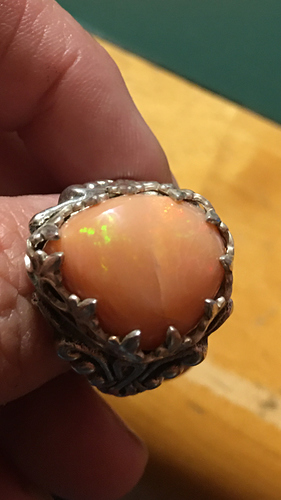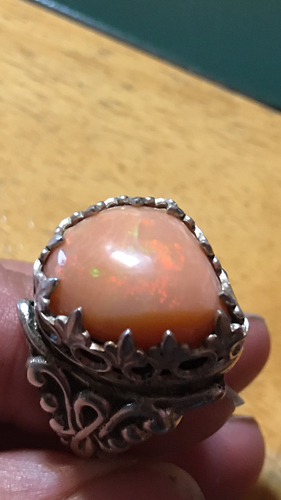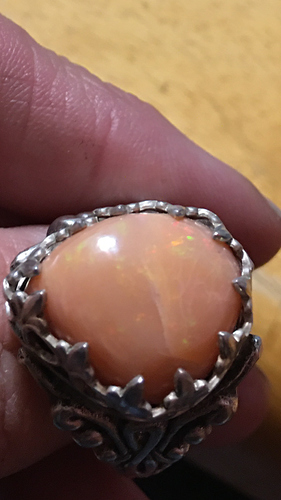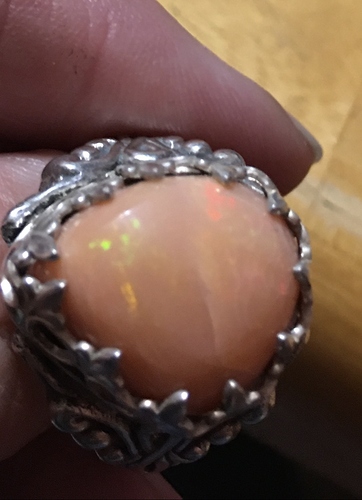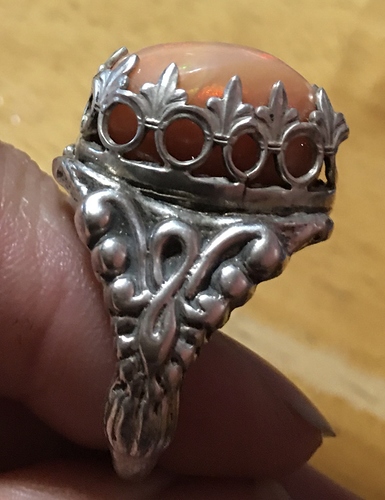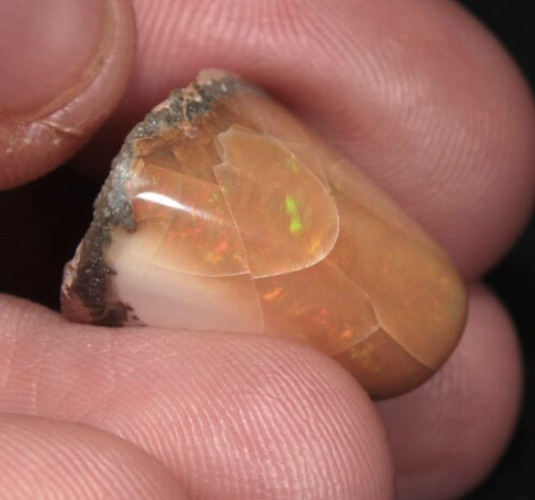Hello everyone! I’m new here and I hope someone may be able to help. Can anyone tell me the value or rarity of this 13.6 carat pink opal set in a ring? It’s actually a peachy-pink. I have never seen a pink opal with play of color like this. It belonged to my friend, who got it from her mom. Her father gave it to her mom over 20 years ago. He worked some opals, but mostly fire agates. It was larger but broke and my friend worked it and her husband set it in the ring. I do not believe it’s dyed as she said the pieces that broke off were the same color throughout. There would also be no reason to dye an opal that large with play of color like that, in my opinion. It is also an older opal and it’s story is lost, as my friend’s father - the original owner- passed away a few years ago. I would greatly appreciate any information any of you can give me. Thank you
Rarity, no. Very typical “Wello” Ethiopian look. Value- lower commercial. Be careful with its wear. Opals are delicate.
It’s funny, I’ve looked up pink opals with play of color and I have yet to find anything other than the fake pink ones. I have seen all kinds of pictures and I’ve never seen a welo opal like this. So I’m guessing you think it’s dyed? Could you please provide some links for me? I’d love to find another one that looks like this for comparison. If you have information, could you please share it? Thank you
It is common opal called “potch”. It comes in a variety of colors: Yellow, dull red, rose (pink), and colorless. For reference check out “The Rock & Gem Book” published by the Smithsonian Institute, pages 118 & 119.
The opal in my ring is not potch opal. I did a little research on that. I have shown pictures to GIA, asked other opal enthusiasts about it and ended up here. What I find most interesting is that everyone has a different answer. The GIA was interested in examining it, but when I asked about cost - crickets. I’ve enclosed the email from them, specifically, Robert Weldon. Maybe it’s not rare, maybe it’s dyed, but I have a hard time believing either. Mostly because no one can provide pictures of others like it or links to show where to find some. I have seen pictures of every other opal, including fake ones, but not one that look like mine. Thank you for responding.
You’re welcome! As you can see it is so difficult to try and identify a gem without physically looking at it.
I don’t think it is Ethiopian opal, it doesn’t appear translucent. Ethiopian opal can be readily dyed as it absorbs water and therefore the base colour can be modified. I’ve seen photos of Australian Opal with a pink background with colourplay. It’s not common, base colour are usually white through grey to black. In any regards your opal needs careful handling. It is heavily crazed, It has “dried out”. To prevent further damage it should be kept out of heat and sunlight and worn sparingly, a decent bump and it will shear I fear.
As to value, due to the crazing, not much unfortunately.
Opals are valued according to size but moreso on quality of colourplay with more value attached to red, then orange then yellow. Purple, blue and green are the most common / least valuable colours. Some opals display their colours in patterns, some of these “pattern” are very desirable and add considerable value. The colour of the base has an impact on value, black (which is actually dark grey) is the most valuable aka Black Opals. This base provides the most striking background for an opals play of colour.
And the play of colour is determined by the size and regularity of the microscopic silicon spheres. Red is the rarest because it requires the largest sphere size to develop undisturbed.
Thank you for responding. I also, do not believe it’s Ethiopia opal. There is red and orange and a hint of yellow, play of color, as well as green. As to the crazing, should I put it in water? Mineral oil? I want to preserve it as best I can, as it will be passed down to my daughter. I was afraid to do anything because I didn’t know what type of opal for sure. I definitely do not want to ruin it. I have a white opal ring that belonged to my mother. Beautiful stones. I put it in mineral oil and the colors really popped.
Hi, no, don’t put it in Any oil ! Just water is ok to clean with but dry off gently. Don’t use any of those commercial gem or metal cleaners. You Can use a silver polishing cloth if you want to shine up the metal.
Once an opal is cracked, basically nothing can be done. You just have to prevent worse cracking by keeping it out of heat and dry environments.
Some jewellers do use a liquid called Opticon. This is the same modern “filler” used to help close off fissures in Emeralds. Emeralds traditionally use Cedar Oil but these days they are Often using Opticon. It’s a permanent treatment. It’s not DYI it needs to be done professionally.
Thank you!! I’m glad you cleared that up!! I was t going to do anything until I knew for sure what to use. I knew not to use any cleaners or things like that. I just want to preserve it. I also didn’t know once the crazing starts, there’s no way to fix it DIY. But it makes perfect sense- cracks are cracks, no type of water or liquid is going to repair that. When you said, “dried out”, my first thought was to add moisture back to replace it. But it’s not a raisin and isn’t going to plump back up lol. Very helpful info you have given me and I really appreciate it. I don’t know how expensive it would be to have Opticon put on it, but right now, I’m afraid to let anyone touch it. I’ve only worn it once and was super careful. Worth anything or not, I think it’s beautiful and I’ve never seen anything like it. I’d love for this to be a family heirloom. Thank you so much!
Having polished Australian opal for more than 40 years, my rule has always been that cracked stones are specimens. Worth a a few dollars at most. It’s heartbreaking to find a beautiful full-of-fire opal with a crack in. Early on I tried to simply recut it, but if it cracks once, it will again. Thus, as Bron357 said there’s nothing to be done. So, if you like the stone, just treat it gently, but if you’re asking the value (for insurance or to sell), then it’s probably not worth the setting it’s in.
Original opal discovery in Ethiopia was in the Shewa area in the early 1990’s, most of which typically cracked very easily as with your example. Notice it is not actually “pink” but more like a caramel color.
@az1067 and jbergman: Double-thanks for conclusively moping up another “heirloom” mess and bringing clarity into the murky opal-world. I’ve been an opalholic for more than a decade: white and boulder rough only. Unfortunately, I’ve watched much of Australian opal mining migrate to mining Youtube revenue instead. Riding the coat-tails of a truly spectacular and courageous mining history, TV producers and a small cabal of these Youtubers have managed to provide a steady stream of “hype-entertainment” and indoctrination online. Black opal, cooked opal, “red, red, red”, doublets, triplets, unverified, spectacular retail and auction prices supposedly paid – on hollow belemnites no less, has done far more harm than good. My latest Australian shipment, nearly 400 bucks worth, bought from the mailing list of a fast-talking “Cary Grant” octogenarian and his clan, is due here in the US any day now. Suffice it to say, I already know that I could have bought twice the quality at less than half the price at opalauctions.com or even US-dealer old-stock. For fun, I may just present images once the stuff turns up here. I hate seeing one of the most beautiful (and fun to work with) gems on the downhill slide of value.
